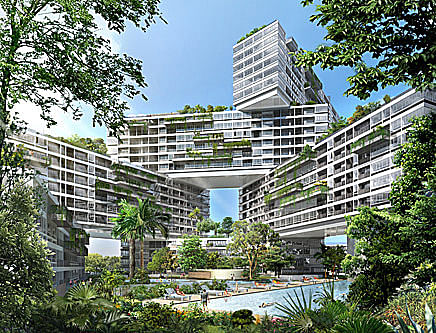

ShowCase is an on-going feature series on Archinect, presenting exciting new work from designers representing all creative fields and all geographies.
We are always accepting nominations for upcoming ShowCase features - if you would like to suggest a project, please send us a message.
The Interlace is one of the largest and most ambitious residential developments in Singapore. It will present a radically new approach to contemporary living in a lush tropical environment.
The project is located on an expansive eight-hectare site in the heart of Singapore’s Southern Ridges and will complete a nine-kilometer green belt of parks and recreational facilities. With about 170,000 square meters of gross floor area, the development will provide over 1,000 condominium units of varying sizes with extensive outdoor spaces and landscaping.
Instead of creating a cluster of isolated, vertical towers – the standard typology of residential developments in Singapore – the design responds to the issues and challenges of tropical living by proposing an expansive network of recreational and dwelling spaces integrated with the natural environment.
↑ Click image to enlarge
The Interlace Condominiums
Thirty-one apartment blocks, each six stories tall, are stacked in a hexagonal arrangement to form eight large-scale open and permeable courtyards. The interlocking volumes form the topography of a ‘vertical village’ with cascading sky gardens and private and public roof terraces vertically extending the landscape of the courtyards. Extensive communal facilities which are embedded in the lush vegetation offer multiple opportunities for social interaction in a natural environment. While maintaining the privacy of the individual apartment units through generous spacing of the building blocks and unobstructed far-ranging views, the horizontal and interconnected volumes create an interactive network of outdoor spaces within the green terrain.
Site and Location
The site is located at the junction of Alexandra Road and Depot Road and is bounded by the Ayer Rajah Expressway to the north. To the south, the Southern Ridges connects The Interlace to the Kent Ridge, Telok Blangah Hill and Mount Faber parks. Together with Gillman Village, residents can enjoy a variety of nature trails and restaurants within walking distance of the site.
Proximity to the West Coast Highway and Ayer Rajah Expressway allows residents to enjoy easy access to numerous points of interest: a five-minute drive to VivoCity, Sentosa and the integrated resort as well as the National University of Singapore; a 10-minute drive to the Central Business District (CBD); and 15 minutes to Orchard Road. In addition, The Interlace is also accessible to various MRT lines via the Queenstown, Redhill, HarbourFront and future Labrador Park MRT stations.
↑ Click image to enlarge
Massing
The 31 six-story blocks are arranged on four main ‘Superlevels’ comprising 24 stories, although most Superlevel blocks range from six to18 stories to form a stepped building topography. By alternating the Superlevel blocks as they are stacked, multi-story openings through the massing allow light and air to weave into the architecture and landscape. Extensive cascading terraces and balconies continue the landscaping features up to the green roofs and shared public terraces between blocks.
Master Plan
The landscape master plan is generated from a series of environmental sun, wind and micro-climate studies, which respond to the existing site conditions and arrangement of the blocks. Eight courtyards with individual landscaped identities are defined within the heart of the project and form focal points and orienting devices for the surrounding blocks. Clubhouse amenities are situated within landscaped areas, integrating communal activities with the outdoors, and extending the boundaries between indoor and outdoor spaces.
The primary route through the project leads residents from the main entrance to the major courtyards where communal events take place. Pedestrian circulation responds to the location and density of residents around each courtyard and residential core. A system of secondary footpaths brings residents on the most direct route from the building entrances to and from their homes. A continuous loop around the site provides a one-kilometer running track and connects the ‘internal’ courtyards to the activities around the edge of the site.
↑ Click image to enlarge
Environmental
A series of site specific environmental studies were carried out and evaluated (wind, solar and daylight analysis) to determine the strategies for the landscape design. Water bodies have been strategically placed within defined wind corridors. This allows evaporative cooling to happen along the wind paths, reducing local air temperatures and improving the thermal comfort of outdoor recreation spaces.
A number of landscaped open-air voids are introduced to allow light and air to the basement level and first floor parking deck, creating areas of lush vegetation and trees below ground and connecting these subterranean spaces visually and through planting, to the courtyards above.
↑ Click image to enlarge
Landscape
The landscape design capitalizes on the generous size of the eight-hectare site and further maximizes the green area and presence of nature. By stacking the apartment blocks, the design generates the opportunity for extensive roof gardens, numerous landscaped public terraces that provide even more green areas than the original site.
The landscape design establishes a link between the existing surrounding parks and green spaces and completes the green belt. Trees, plants and flowers form a part of the residential program and provide a lush tropical environment for the residents to enjoy and provide settings for leisure activities. The continuity of the landscape is also projected vertically, from the planting of green areas in the open-air basement voids, up to the balconies and rooftop gardens.
Private balconies are arranged to give apartments generous outdoor space and private planting areas. A succession of cascading gardens in the sky are expressed on the building facades, as lush vegetation spills over balconies, visually connecting the elevated green refuges with the expansive tropical landscape on the ground. The project is not only infiltrated by the surrounding tropical flora, but also embedded in it, allowing nature to expand sustainably within and throughout the project.
↑ Click image to enlarge
Site Access
The main entrance of the development for both pedestrian and vehicular drop-off occurs at the Entry Plaza, marked by a large covered canopy structure located at the front of the site. The private shuttle bus stop and taxi drop-off are located under this canopy, and a pedestrian entrance is provided with access to the public bus stop. Vehicular traffic enters and exits via Depot Road at the south-east corner of the site.
The Entry Plaza is directly linked to the Pedestrian Connector which brings residents to the courtyards and joins the retail and clubhouse facilities. Two secondary pedestrian entrances at the south-west and north-west corners of the site provide additional resident access to the site.
Roof Gardens
Two types of roof garden space are provided – Sky Gardens located where there are blocks overhead; and private roof gardens located on roofs open to the sky. The Sky Gardens offer a variety of public programs and can be used by all residents.
Panoramic views across and beyond the site are offered throughout the project, given the advantageous site elevation, massing and overall height. Views from Superlevel 2 Sky Gardens will be at the top of the tree canopy; therefore creating a more enclosed feeling and a focus on foreground. Views from Superlevel 3 & 4 will be well above the surrounding tree canopy, offering distant panoramic views of Singapore’s CBD and the Sentosa coastline towards the sea.
↑ Click image to enlarge
Developer: A CapitaLand-led consortium comprising CapitaLand Residential Singapore Pte Ltd, Hotel Properties Limited and a third shareholder.
Lead Designer: Ole Scheeren, Office for Metropolitan Architecture (OMA) Beijing
Project Architect: RSP Architects Planners & Engineers (Pte) Ltd
Landscape Architect: ICN Design International Pte Ltd
Quantity Surveyor: Davis Langdon & Seah Singapore Pte Ltd
Type of Development: Condominium comprising 1,040 units with extensive clubhouse facilities and retail storefronts
Unit Types: A range of two-, three- and four-bedroom apartments, penthouses and duplex garden units. Areas will vary from 75 square meters for a two-bedroom unit to 586 square meters for a penthouse with private roof garden
Site Area: Approximately 81,000 square meters (871,884 square feet)
Gross Floor Area: Approximately 170,000 square meters (1.8 million square feet)
Floors: 24 stories above ground with one level of basement parking
The Office for Metropolitan Architecture (OMA) is a leading international partnership practicing contemporary architecture, urbanism, and cultural analysis. The office is led by six partners – Rem Koolhaas, Ole Scheeren, Ellen van Loon, Reinier de Graaf, Shohei Shigematsu and Managing Partner, Victor van der Chijs – and employs a staff of around 220 people of more than 35 nationalities.
OMA’s recently completed projects include Prada Transformer, a rotating multi-use pavilion in Seoul (2009), the Zeche Zollverein Historical Museum and master plan in Essen (2006), the Seoul National University Museum of Art (2005), the much acclaimed Casa da Música in Porto (2005), the Prada Epicenter in Los Angeles (2004), the Seattle Central Library (2004), the Leeum Samsung Museum of Art in Seoul (2004), the Netherlands Embassy in Berlin (2003), the IIT Campus Center in Chicago (2003), and the Prada Epicenter in New York (2001).
The work of Rem Koolhaas and OMA has won several international awards including the Pritzker Architecture Prize in 2000, the Praemium Imperiale (Japan) in 2003, the RIBA Gold Medal (UK) in 2004, and the Mies van der Rohe – European Union Prize for Contemporary Architecture (2005).
Creative Commons License
This work is licensed under a Creative Commons License .
/Creative Commons License
7 Comments
Interesting design!
As an architectural visualizer, it hurts me to see the quality of those renderings. This design could have looked so much richer if they paid a little more money for those renderings. Seems like architectural visualization is going backwards these days...
i don't know my gut reaction is 'puke' - it looks like a lame massing model decorated by a developer
what? pay more money for renderings? you know what, i am more interested in the built, and less interested in renderings. how often, if ever, do renderings represent the final product?
The architecture and urban approach of this project are very interesting.
but speaking of developers i would like to know more about the marketability of such huge projects. as you see this is a 170000sqm on an 81000sqm site.
compare this to the biggest building in your neighborhood?
this is absurd even tending to stupid
The top image belies a much more idyllic setting/landscape than other images and further reading of the project makes clear.
Especially the second image portraying the site's proximity to the major roadway.
Although i suppose for such a high-end development that artificially produced serenity may be a selling point.
it has the typical OMA attitude/arrogance.

I think this is nice but I'm not that impressed. :D
Block this user
Are you sure you want to block this user and hide all related comments throughout the site?
Archinect
This is your first comment on Archinect. Your comment will be visible once approved.